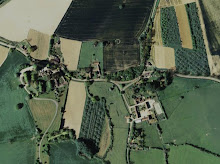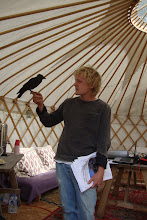
Wold's End orchard is close to the centre of my beautiful local town, Chipping Campden. Over the last 30 years this orchard has been at the heart of an argument that has polarised opinion in the town. The land is owned by The Campden Society who successfully applied for planning permission to convert a section of the orchard (about 1/3) into a car park. Later the permission was changed to permit the building of a new doctor's surgery. Fortunately, The Campden Society does not currently have the money to undertake the development and things are on hold - but the plans have not been retracted.

The Campden Society is established for the public benefit for the following purposes (bold my own):
1. To secure the protection of the architectural and historic quality of Campden, its open spaces and its natural setting.
2. To promote high standards of planning, architecture and landscaping in Campden.
3. To stimulate interest in and concern for the character and beauty of Campden.
The tarmac path in this picture was added for 'pedestrian access'. Some work had to be undertaken to prevent the planning permission from expiring.

Ordnance survey map of Chipping Campden from between c.1843 and c.1893. Notice the abundance of small orchards in the land to the right of Wold's End.

Wold's End orchard is a rare example of an old traditional orchard that retains most of its original trees close to the centre of a historic Cotswold market town. Traditional orchards in towns and villages are very vulnerable to development and successful resistance to such changes happens only rarely (e.g. Brockworth orchard). Campden appears to have changed relatively little in the last 160 years, but many of the orchards to the east of the town have succumbed to development. Interestingly, apparently the boundary for the 'conservation area' includes all the green space surrounding the orchard, but not the orchard itself. Has it always been earmarked for development?

There are 47 old trees left in the orchard, many of great age and rich in veteran tree features that are so ecologically diverse. This is one of the reasons why traditional orchards are now a UK Biodiversity Action Plan 'priority' habitat. The one in the foreground here is almost completely hollow and would be a good place to look for Noble Chafer (Gnorimus nobilis) frass.

All the fruit trees populating the edge abutting Back End lane will be lost in the proposed development. That includes the three seen here in the foreground (the nearest is an ash). I'm not sure security lights will age so gracefully. A huge amount of soil will also need removing to flatten this section.

In 1994 there was a topographical survey of the site undertaken by the Cotswold Archaeological Trust. It found that the most significant archaeological feature of the site was the ridge and furrow earthworks that are likely to be of medieval origin and 'lend themselves to a visual appreciation of the medieval and later agricultural activity surrounding the settlement of Chipping Campden'. Orchards and woodlands are excellent places to see these agricultural fingerprints that are quickly eroded by mechanised farming methods.

Certain members of The Campden Society seem to have forgotten that its role is for promoting conservation and not development. Fortunately there are people in the town that appreciate that our heritage does not always come packaged in Cotswold stone - the group 'Caring for Campden' have been fighting to preserve the orchard, listing arguments against the initial parking justification. I can now add to their arguments my own: that from my experience of visiting and surveying the ecological aspects of traditional orchards, the Wold's End orchard is site of immense value.
Crucially, recent efforts have been made to restore the site, with many new trees on appropriate vigorous rootstocks that will ensure there is a new generation to replace those that die. A central position in a historic and popular town should allow school children, residents and the general public to be educated in the value of traditional orchards: the ecological value, their place as a legacy of our farming heritage and as a means of reconnecting an increasingly urbanised nation with biodiversity. Acres and acres of the countryside are monocultures of arable crops with very little variety or room for nature - why do the car parks and new houses have to be built on these rare fragments of land that have interest above and beyond a focus on productivity?

However, the future is not entirely gloomy for Wold's End orchard. Unlike the majority of traditional orchards in Britain, this one is not left unused. Chipping Campden School has rented the site on a 'peppercorn rent' (i.e. very small amount) and uses it as a practical space for their Environmental and Land-based Science GCSE and 'rural crafts' course. Children have helped to restore the orchard by grafting the existing varieties and caring for the Gloucestershire Old Spot pigs that have provided pork for the school canteen. 20 new apple trees, 2 pears and a walnut have been planted and trees have been pruned. Numerous fruit trees have been planted around the school as well.
Have a look at this article.
And if you can, go down and visit the orchard and make your own mind up. And get in touch with the Campden Society and get your views heard.

